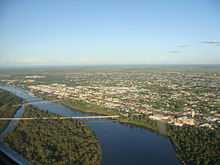Burnett River
| Burnett River | |
 The Burnett River with the city of Bundaberg to the right | |
| Country | Australia |
|---|---|
| State | Queensland |
| Tributaries | |
| - right | Nogo River, Auburn River, Boyne River, Barambah Creek |
| Cities | Mundubbera, Gayndah, Wallaville, Bundaberg, Burnett Heads |
| Source | Mount Gaeta |
| - location | near Monto, Queensland |
| - coordinates | 24°51′S 151°36′E / 24.850°S 151.600°E |
| Mouth | Pacific Ocean |
| - location | Burnett Heads, Qld |
| - elevation | 0 m (0 ft) |
| - coordinates | 24°45′16″S 152°23′48″E / 24.75444°S 152.39667°E |
| Length | 435 km (270 mi) |
| Basin | 32,220 km2 (12,440 sq mi) |
The Burnett River is a river in central Queensland, Australia that empties into the Pacific Ocean near the city of Bundaberg. The Burnett River region is largely given over to growing sugar cane and small crops.
The Burnett River, together with the nearby Mary River, is home to the Queensland lungfish, one of the most ancient of the extant vertebrate species.
Construction of the Paradise Dam on the Burnett River, 80 kilometres upstream from Bundaberg, was completed in November 2005. The dam has a capacity of 300,000 megalitres. The dam is named after the old gold mining township of Paradise, which is now submerged under the waters of the reservoir. All of the structures and artefacts found at the site have been transferred to the nearby town of Biggenden. The design of the dam complies with strict environmental guidelines and includes a 'fishway' that allows fish such as the Queensland lungfish to travel upstream as well as downstream from the dam wall.
The river rises close to Mount Gaeta, east of Monto, flowing in a general southerly direction past Eidsvold and Mundubbera. Downstream of Mundubbera, the river swings east, going through the townships of Gayndah and Wallaville before entering the city of Bundaberg. The river flows into the ocean at Burnett Heads, roughly 20 km from Bundaberg.
The river is named after James Charles Burnett, the explorer who discovered it in 1847.[1]
Tributaries


Major tributaries of the Burnett River include:
- Three Moon Creek: Rises near Kroombit Tops National Park north of Monto. Flows south through Monto and Mulgildie before emptying into the Burnett River south-east of Abercorn. Part of the creek is dammed near Cania Gorge to form Lake Cania.
- Nogo River: Rises in the hills north-west of Monto. Flows south-east to join the Burnett near Ceratodus. Part of the Nogo River is dammed west of Abercorn to form Wuruma Lake, a popular fishing spot.
- Auburn River: Rises in the hills about 20 km west of Cracow. Flows south before swinging to the north-east at its confluence with Johnson Creek. Passes through Auburn River National Park, a little-known and untouched piece of pristine bush including Auburn Waterfall. Flows into the Burnett River west of Mundubbera.
- Boyne River: Rises in the Bunya Mountains National Park south-west of Kingaroy. Flows in a general northerly direction, emptying into the Burnett River near Mundubbera, only 5 km from the Burnett River-Auburn River confluence. Part of the Boyne River is dammed near Proston to form Lake Boondooma, which supplies water for the Tarong Power Station near Kingaroy. (Another Boyne River, not part of the Burnett system, is located near Gladstone).
- Barambah Creek: Rises in the hills between Kingaroy and the Sunshine Coast, north of Jimna. Flows in a general northerly direction before meeting the Burnett River north-east of Gayndah. Part of Barambah Creek is dammed south of Murgon to form Lake Barambah, also known as Bjelke-Petersen Dam, named after former Premier Joh Bjelke-Petersen.
2010–2011 Queensland floods
The Burnett River catchment is one of the areas that has been part of the 2010–2011 Queensland floods.
References
- ↑ Reed, A. W. (1973). Place Names of Australia, p. 49. Sydney: A. H. & A. W. Reed. ISBN 0-589-07115-7.
External links
| Wikimedia Commons has media related to Burnett River. |
| |||||||||||||||||||||||||||||||||||||||||||||